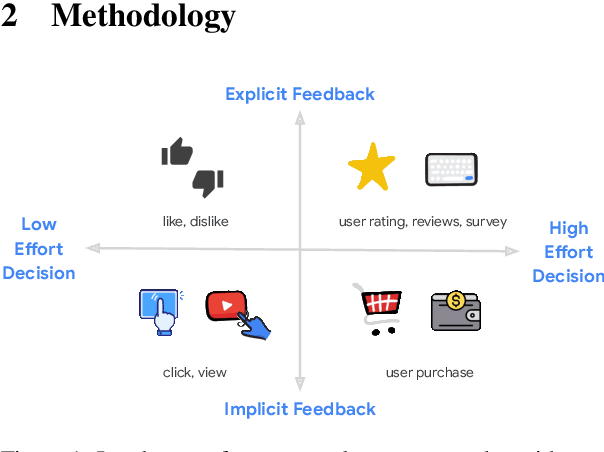Taibai Xu
STAR: A Simple Training-free Approach for Recommendations using Large Language Models
Oct 21, 2024Abstract:Recent progress in large language models (LLMs) offers promising new approaches for recommendation system (RecSys) tasks. While the current state-of-the-art methods rely on fine-tuning LLMs to achieve optimal results, this process is costly and introduces significant engineering complexities. Conversely, methods that bypass fine-tuning and use LLMs directly are less resource-intensive but often fail to fully capture both semantic and collaborative information, resulting in sub-optimal performance compared to their fine-tuned counterparts. In this paper, we propose a Simple Training-free Approach for Recommendation (STAR), a framework that utilizes LLMs and can be applied to various recommendation tasks without the need for fine-tuning. Our approach involves a retrieval stage that uses semantic embeddings from LLMs combined with collaborative user information to retrieve candidate items. We then apply an LLM for pairwise ranking to enhance next-item prediction. Experimental results on the Amazon Review dataset show competitive performance for next item prediction, even with our retrieval stage alone. Our full method achieves Hits@10 performance of +23.8% on Beauty, +37.5% on Toys and Games, and -1.8% on Sports and Outdoors relative to the best supervised models. This framework offers an effective alternative to traditional supervised models, highlighting the potential of LLMs in recommendation systems without extensive training or custom architectures.
Leveraging LLM Reasoning Enhances Personalized Recommender Systems
Jul 22, 2024



Abstract:Recent advancements have showcased the potential of Large Language Models (LLMs) in executing reasoning tasks, particularly facilitated by Chain-of-Thought (CoT) prompting. While tasks like arithmetic reasoning involve clear, definitive answers and logical chains of thought, the application of LLM reasoning in recommendation systems (RecSys) presents a distinct challenge. RecSys tasks revolve around subjectivity and personalized preferences, an under-explored domain in utilizing LLMs' reasoning capabilities. Our study explores several aspects to better understand reasoning for RecSys and demonstrate how task quality improves by utilizing LLM reasoning in both zero-shot and finetuning settings. Additionally, we propose RecSAVER (Recommender Systems Automatic Verification and Evaluation of Reasoning) to automatically assess the quality of LLM reasoning responses without the requirement of curated gold references or human raters. We show that our framework aligns with real human judgment on the coherence and faithfulness of reasoning responses. Overall, our work shows that incorporating reasoning into RecSys can improve personalized tasks, paving the way for further advancements in recommender system methodologies.
Hiformer: Heterogeneous Feature Interactions Learning with Transformers for Recommender Systems
Nov 10, 2023



Abstract:Learning feature interaction is the critical backbone to building recommender systems. In web-scale applications, learning feature interaction is extremely challenging due to the sparse and large input feature space; meanwhile, manually crafting effective feature interactions is infeasible because of the exponential solution space. We propose to leverage a Transformer-based architecture with attention layers to automatically capture feature interactions. Transformer architectures have witnessed great success in many domains, such as natural language processing and computer vision. However, there has not been much adoption of Transformer architecture for feature interaction modeling in industry. We aim at closing the gap. We identify two key challenges for applying the vanilla Transformer architecture to web-scale recommender systems: (1) Transformer architecture fails to capture the heterogeneous feature interactions in the self-attention layer; (2) The serving latency of Transformer architecture might be too high to be deployed in web-scale recommender systems. We first propose a heterogeneous self-attention layer, which is a simple yet effective modification to the self-attention layer in Transformer, to take into account the heterogeneity of feature interactions. We then introduce \textsc{Hiformer} (\textbf{H}eterogeneous \textbf{I}nteraction Trans\textbf{former}) to further improve the model expressiveness. With low-rank approximation and model pruning, \hiformer enjoys fast inference for online deployment. Extensive offline experiment results corroborates the effectiveness and efficiency of the \textsc{Hiformer} model. We have successfully deployed the \textsc{Hiformer} model to a real world large scale App ranking model at Google Play, with significant improvement in key engagement metrics (up to +2.66\%).
 Add to Chrome
Add to Chrome Add to Firefox
Add to Firefox Add to Edge
Add to Edge